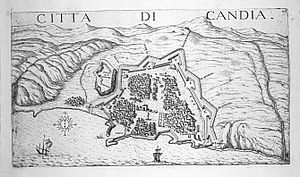
Crete is the largest and most populous of the Greek islands, the 88th largest island in the world and the fifth largest island in the Mediterranean Sea, after Sicily, Sardinia, Cyprus, and Corsica. Crete rests about 160 km (99 mi) south of the Greek mainland, and about 100 km (62 mi) southwest of Anatolia. Crete has an area of 8,450 km2 (3,260 sq mi) and a coastline of 1,046 km (650 mi). It bounds the southern border of the Aegean Sea, with the Sea of Crete to the north and the Libyan Sea to the south. Crete covers 260 km from west to east but is narrow from north to south, spanning three longitudes but only half a latitude.

Heraklion or Herakleion, sometimes Iraklion, is the largest city and the administrative capital of the island of Crete and capital of Heraklion regional unit. It is the fourth largest city in Greece with a municipal population of 179,302 (2021) and 211,370 in its wider metropolitan area, according to the 2011 census.
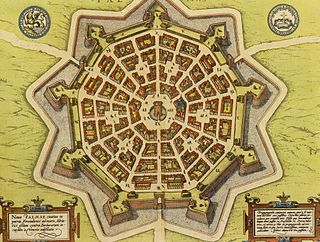
A bastion fort or trace italienne is a fortification in a style that evolved during the early modern period of gunpowder when the cannon came to dominate the battlefield. It was first seen in the mid-fifteenth century in Italy. Some types, especially when combined with ravelins and other outworks, resembled the related star fort of the same era.

Spinalonga is an island located in the Gulf of Elounda in north-eastern Crete, in the municipality of Agios Nikolaos, Lasithi, next to the town of Plaka. The island is further assigned to the area of Kalydon. It is near the Spinalonga peninsula – which often causes confusion as the same name is used for both.

The siege of Rhodes of 1522 was the second and ultimately successful attempt by the Ottoman Empire to expel the Knights of Rhodes from their island stronghold and thereby secure Ottoman control of the Eastern Mediterranean. The first siege in 1480 had been unsuccessful. Despite very strong defenses, the walls were demolished over the course of six months by Turkish artillery and mines.
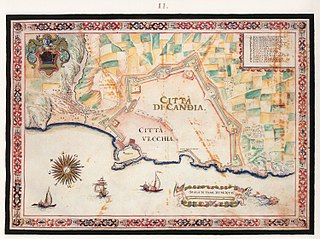
The Cretan War, also known as the War of Candia or the Fifth Ottoman–Venetian War, was a conflict between the Republic of Venice and her allies against the Ottoman Empire and the Barbary States, because it was largely fought over the island of Crete, Venice's largest and richest overseas possession. The war lasted from 1645 to 1669 and was fought in Crete, especially in the city of Candia, and in numerous naval engagements and raids around the Aegean Sea, with Dalmatia providing a secondary theater of operations.

The Frankokratia, also known as Latinokratia and, for the Venetian domains, Venetokratia or Enetokratia, was the period in Greek history after the Fourth Crusade (1204), when a number of primarily French and Italian states were established by the Partitio terrarum imperii Romaniae on the territory of the dissolved Byzantine Empire.

The Koules or Castello a Mare is a fortress located at the entrance of the old port of Heraklion, Crete, Greece. It was built by the Republic of Venice in the early 16th century, and is still in good condition today.

The Fortezza is the citadel of the city of Rethymno in Crete, Greece. It was built by the Venetians in the 16th century, and was captured by the Ottomans in 1646. By the early 20th century, many houses were built within the citadel. These were demolished after World War II, leaving only a few historic buildings within the Fortezza. Today, the citadel is in good condition and is open to the public.
Palaiokastro is a coastal village and a community in the municipality of Malevizi. 9 km west of Heraklion on the island of Crete. It is situated in front of a 70 meter long pebbled beach leading to a cove with rapidly deepening waters that are protected from the prevailing northerly winds. On the southern end of the beach rises a steep calcareous rock. During the Venetian occupation of Crete extensive fortifications were built on this rock, housing cannons that secured the bay of Heraklion. Ruins of the fortress walls survive until today.
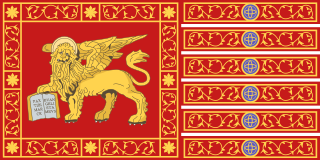
The Realm or Kingdom of Candia or Duchy of Candia was the official name of Crete during the island's period as an overseas colony of the Republic of Venice, from the initial Venetian conquest in 1205–1212 to its fall to the Ottoman Empire during the Cretan War (1645–1669). The island was at the time and up to the early modern era commonly known as Candia after its capital, Candia or Chandax. In modern Greek historiography, the period is known as the Venetocracy.

The Walls of Nicosia, also known as the Venetian Walls, are a series of defensive walls which surround Nicosia, the capital city of Cyprus. The first city walls were built in the Middle Ages, but they were completely rebuilt in the mid-16th century by the Republic of Venice. The walls are still largely intact, and are among the best preserved Renaissance fortifications in the Eastern Mediterranean. They are a major tourist attraction.

The Old Fortress of Corfu is a Venetian fortress in the city of Corfu. The fortress covers the promontory which initially contained the old town of Corfu that had emerged during Byzantine times.

The fortifications of Valletta are a series of defensive walls and other fortifications which surround Valletta, the capital city of Malta. The first fortification to be built was Fort Saint Elmo in 1552, but the fortifications of the city proper began to be built in 1566 when it was founded by Grand Master Jean de Valette. Modifications were made throughout the following centuries, with the last major addition being Fort Lascaris which was completed in 1856. Most of the fortifications remain largely intact today.

The fortifications of Chania are a series of defensive walls and other fortifications which surround the city of Chania in Crete, Greece. The inner city walls were first built in antiquity, and were rebuilt by the Byzantine Empire. The outer walls were built in the 16th century by the Republic of Venice. Some of the fortifications were demolished in the 20th century, but parts of both the Byzantine and Venetian walls remain intact.

The fortifications of Famagusta are a series of defensive walls and other fortifications which surround the city of Famagusta in Northern Cyprus. The walls were built by the Lusignan Kingdom of Cyprus in the 14th century, and redesigned by Republic of Venice in 15th and 16th centuries before the siege of Ottoman Empire in 1571. The fortifications of Famagusta withstood an 11-month siege before the city capitulated to the Ottoman Empire in August 1571.
The Conspiracy of Sifis Vlastos was a fifteenth-century planned rebellion against the Republic of Venice in the overseas colony of Crete, named after its chief instigator. Vlastos and his collaborators were betrayed to the Venetian authorities, who swiftly arrested and executed them in 1454. A smaller, follow-on plan for an intended uprising against Venice was dismantled in 1462.

The Cathedral of Saint Titus also known as Hagios Titos, is an Orthodox church in the city of Heraklion, Crete, dedicated to Saint Titus. The current church was built in 1869 as the Yeni Cami after the previous building was destroyed by the earthquake of 1856. In 1925 it was converted to Christian worship. The church was declared a cathedral of the archdiocese of Crete in 2013. The church is an eclectic style square temple with a dome. The exterior of the temple is dominated by vertical elements, while at the top there is a stone-carved apse.

The Basilica of Saint Mark, also known as Hagios Markos, is a former Roman Catholic church in the center of the city of Heraklion, Crete, in the Eleftheriou Venizelou Square. It was built during the Venetian rule of the island in 1239, primarily used by the local lords and officials of the island. After the Ottoman conquest of Crete in 1669, it was converted into a mosque with the name Defterdar Ahmet Pasha Mosque, and remained so until 1915. The building was restored after 1956 and ever since functions as a public art gallery. It is one of the few Roman Catholic churches still standing in Cretan cities and towns. Architecturally-wise it is a three-aisled basilica church with an elevated central nave. It has a portico in its entrance in the western façade.
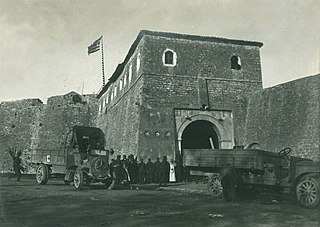
The Castle of Saint Andrew is a fortress in Preveza, Greece. First constructed by the Ottoman Empire in the early 1700s, it was expanded under Venetian rule in 1718–1797 and again under the autonomous regime of Ali Pasha of Yanina in 1807–1808 to become the largest of the several fortifications in the Preveza area.

